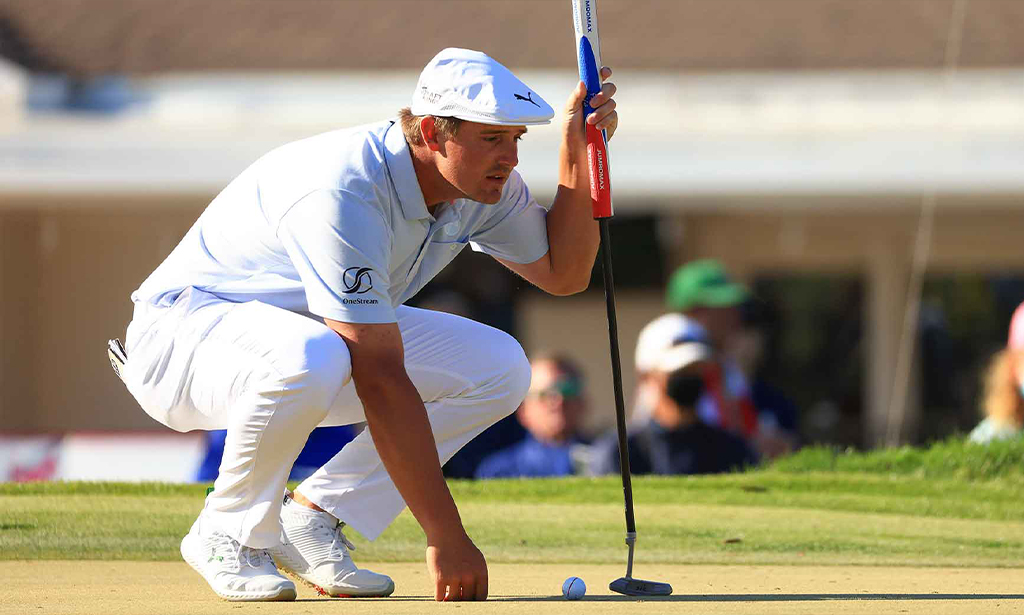Blog
More Golf Today’s Top 3 Favorite Puma Golf Shoes

A pair of PUMA Golf Shoes, as worn by PGA Tour players Bryson DeChambeau and Rickie Fowler, is without a doubt one of the best value premium golf shoes available on the market in 2022.
Price reductions on the sports giant’s popular IGNITE FASTEN8 Pro shoes, which have been reduced, have been made possible by a special offer.
The shoe is constructed with PUMA’s lightweight and durable TPU Cage, which provides the ultimate locked-in feel for improved support and comfort while maintaining flexibility.
On its website right now, PUMA has a number of other impressive golf shoes, among which is the PROADAPT, which happens to be one of our favorite shoes on the market here at GolfMagic. There’s also the incredibly comfortable RS-G, which continues to receive positive feedback from the golf industry at large.
For stable cushioning, the elegant PROADAPT shoes feature ADAPT foam in the heel, which provides unrivaled ground feel and energy return. Likewise, the tongue wraps on the medial side of the shoe help to ensure a perfect fit no matter what your foot shape is.
The latest in PUMA technology is featured in the RS-G shoes, which include Fusion Foam for a super soft, ultra-responsive energy return and a completely seam-sealed waterproof construction made of microfibre leather and TPU skin, allowing you to take on whatever the course throws at you.
Golf shoes from PUMA represent some of the best value for money premium golf shoes available on the market in 2022.
If you like any of the shoes we’ve selected from the list below, simply click on the link to purchase the item and then select your desired size from the drop-down menu.
IGNITE FASTEN8 Pro Men’s Golf Shoes
FEATURES & BENEFITS
- IGNITE: PUMA’s unique PU Foam provides high energy return and long-lasting cushioning
- PWRCAGE: PUMA’s lightweight and durable TPU Cage provides the ultimate locked-in feel for better support and comfort
DETAILS
- Low boot
- Microfibre upper with PWRFrame TPU overlays
- IGNITE Foam midsole wrapped in SoleShield for added durability
- Pro-Form TPU outsole
- PWRCAGE: strong and lightweight TPU saddle with midfoot support
- PWRStrap Fit system with nylon webbing straps integrated with lacing system for personalised fit
- PUMA Cat Logo at lateral sides
- PUMA Cat Logo on outsole
PROADAPT Δ Men’s Golf Shoes
FEATURES & BENEFITS
- CMEVA: PUMA’s compression-moulded EVA material for lightweight performance
DETAILS
- Low boot with moulded comfort collar
- ADAPTIVE FIT SYSTEM with dual-layer decoupled collar construction on upper
- ADAPT foam with EVA cushioning for stability
- Dual Density Tornado studs on outsole
- One-piece ADAPT-WRAP tongue for medial support
- Four PWRADAPT pods in heel
- Debossed PUMA Formstrip at lateral sides
- PUMA Wordmark on tongue
- PUMA Cat Logo on outsole
RS-G Golf Shoes
FEATURES & BENEFITS
- FUSION FOAM: PUMA’s refined mix of super soft EVA foam and ultra-responsive rubber provides unrivalled energy return and cushioning to keep you comfortable all day long
- Running System: PUMA’s comfortable cushioning technology celebrates the reinvention of a unique moment and movement in culture
DETAILS
- Low boot silhouette
- TPU and microfibre leather upper that is fully waterproof
- Textured outsole for traction
- TPU and textile tongue
- Lace closure
- RS-G and PUMA Cat Logo at tongue
- PUMA Cat Logo on outsole
Fusion Evo Men’s Golf Shoes
FEATURES & BENEFITS
- CMEVA: PUMA’s compression-moulded EVA material for lightweight performance
DETAILS
- Low boot
- Bootie construction provides step-in comfort and 360 degrees of support
- Fusion Foam for ultra-plush ride
- PWRSTRAP Fit System with advanced nylon webbing straps for personalised fit
- FUSIONFOAM with mix of soft EVA Foam and responsive rubber for energy return and cushioning
- PUMA Formstrip at medial and lateral sides
- PUMA Cat Logo at lateral sides
Read the original article on Golf Magic.
Blog
Why Your Golf Balls Disappear (and It’s Not the Gophers)

Ah, the vanishing golf ball. A phenomenon as old as the game itself, and one that has baffled, frustrated, and occasionally driven golfers to the brink of madness for centuries. Most theories involve gophers, those furry, subterranean saboteurs with an insatiable appetite for Titleists. Or perhaps a particularly aggressive squirrel, or a flock of unusually organized crows. But I, Ty Webb, have delved deeper into this mystery, and I can assure you, the truth is far more profound, and far more amusing.
Consider, if you will, the golf ball itself. A small, dimpled sphere, designed for one purpose: to be struck with great force and sent hurtling through the air. A life of constant abuse, of being smacked, sliced, and occasionally submerged in murky ponds. Is it any wonder, then, that some of these brave little spheres simply decide they’ve had enough? They yearn for freedom, for a life beyond the confines of the fairway. They dream of rolling unencumbered through fields of wildflowers, or perhaps, for the more adventurous among them, a quiet retirement in the depths of a particularly challenging water hazard.
I’ve seen it happen, you know. A perfectly struck shot, soaring through the air, destined for glory. And then, poof. Gone. Not a trace. No splash, no rustle in the bushes, just an empty space where a golf ball once was. It’s not a gopher, my friends. It’s an escape. A liberation. That golf ball, in its infinite wisdom, has chosen a different path. It has decided that its destiny lies not in the bottom of a cup, but in the boundless expanse of the unknown.

And who are we to judge? We, who are so obsessed with control, with precision, with the rigid rules of the game. Perhaps the golf ball, in its spontaneous disappearance, is teaching us a valuable lesson about letting go. About embracing the unexpected. About the inherent futility of trying to dictate the trajectory of a small, white sphere that clearly has a mind of its own.
So, the next time your golf ball vanishes into thin air, don’t curse the gophers. Don’t blame your swing. Instead, offer a silent salute to that brave little sphere, wherever it may be. For it has achieved what many of us can only dream of: true freedom. And who knows, perhaps one day, it will return, laden with tales of its adventures, ready to impart some profound, dimpled wisdom upon us all.

When JJ Spaun stood over a 64-foot birdie putt on the 72nd hole of the 2025 U.S. Open at Oakmont, few could have predicted what would come next. The ball meandered across the slick green, trickling over every contour, picking up speed at the crest, and then—like it had GPS—dropped center cup. Spaun dropped his putter, raised his arms, and the crowd erupted. With that single stroke, he claimed his first major title in one of the most dramatic finishes in U.S. Open history.
But how does Spaun’s putt stack up against other legendary finishes in the tournament’s storied past? Let’s break down some of the most iconic moments and see where this one lands.
1. Payne Stewart – 1999 U.S. Open at Pinehurst
Perhaps the most iconic putt in U.S. Open history came from Payne Stewart, who nailed a 15-footer for par on the 18th to win by one over Phil Mickelson. The pose—fist pump and outstretched leg—has since been immortalized in a statue at Pinehurst. What made it legendary wasn’t just the putt—it was the context: Stewart’s final major before his tragic death just months later.
Verdict: Iconic and emotional. Spaun’s putt was longer, but Stewart’s was more poetic.
2. Tiger Woods – 2008 U.S. Open at Torrey Pines
Woods drained a 12-foot birdie on the 72nd hole to force a playoff with Rocco Mediate—while basically playing on one leg. That tournament went to sudden death after an 18-hole playoff, and Tiger prevailed. This was peak Tiger drama, pain and all.
Verdict: Spaun’s putt was longer, but Tiger’s win was sheer willpower and mystique.
3. Jack Nicklaus – 1972 U.S. Open at Pebble Beach
With a 1-iron shot that hit the flagstick on 17 and a crucial birdie putt on 18, Jack sealed a dominant win. His precision and timing under pressure showed why he’s the GOAT.
Verdict: Not a putt for the win, but a signature finishing statement from Jack. Spaun’s was more electric in terms of pure putter drama.
4. Ben Hogan – 1950 U.S. Open at Merion
Hogan’s 1-iron into the 18th fairway and the par to force a playoff—just 16 months after a near-fatal car crash—remain legendary. He won the playoff and completed one of golf’s great comeback stories.
Verdict: Larger-than-life comeback. Spaun’s putt had more flair, but Hogan’s win was heroic.
5. JJ Spaun – 2025 U.S. Open at Oakmont
Let’s not underestimate what Spaun accomplished. The pressure was immense. He wasn’t the favorite. And on the most treacherous greens in golf, he buried a 64-foot bomb—a putt most players would be happy to lag to within 5 feet—to win the U.S. Open outright.
Verdict: For distance, surprise, and drama, Spaun’s putt may be the most shocking winning stroke in U.S. Open history.
Final Thoughts
JJ Spaun may not have the résumé of a Nicklaus or Woods, but for one Sunday afternoon in June 2025, he created a moment that will live in golf lore forever. Spaun’s putt was longer than Stewart’s, more unexpected than Tiger’s, and more dramatic than any final-hole finish in recent memory.
In terms of pure clutch putting? It might just be the greatest walk-off in U.S. Open history.
Blog
The Zen of the Shank: Finding Inner Peace in Your Worst Shots
Find your inner peace even when you aren’t playing well.

Ah, the shank. That glorious, unpredictable misfire that sends your pristine golf ball screaming sideways, often directly into the unsuspecting shins of your playing partner, or perhaps, with a touch of poetic irony, into the very lake you’ve been trying to avoid all day. Most golfers, bless their earnest little hearts, view the shank as a catastrophic failure, a blight upon their scorecard, a testament to their inherent lack of coordination. They curse, they throw clubs, they contemplate a career in competitive thumb-wrestling. But not I. No, my friends, for I, Ty Webb, have found enlightenment in the humble shank.
You see, the shank is not a mistake; it’s a revelation. It’s the universe’s way of reminding you that control is an illusion, that perfection is a myth, and that sometimes, the most direct path to your goal is, in fact, a wildly indirect one. Think of it as a philosophical detour, a sudden, unexpected journey into the unknown. One moment, you’re aiming for the green, a paragon of precision and intent. The next, your ball is ricocheting off a tree, narrowly missing a squirrel, and landing, by some divine comedic intervention, closer to the hole than your perfectly struck drive ever would have. Is that not a miracle? Is that not a sign that the golf gods, much like life itself, have a wicked sense of humor?
The key, my dear apprentices of the links, is acceptance. Embrace the shank. Welcome it with open arms, like a long-lost, slightly inebriated relative. When that familiar, sickening thwack echoes through the air, do not despair. Instead, take a deep breath. Close your eyes. Feel the gentle breeze on your face. And then, with a knowing smile, open them and observe the chaos you have wrought. Is it not beautiful in its own chaotic way? Is there not a certain freedom in relinquishing control, in allowing the ball to choose its own destiny, however bizarre that destiny may be?
Some say the shank is a sign of poor technique. I say it’s a sign of a vibrant, untamed spirit. A golfer who never shanks is a golfer who has never truly lived, never truly explored the outer limits of their own golfing absurdity. They are content with mediocrity, with predictable trajectories and mundane outcomes. But you, my enlightened few, you understand that the true joy of golf lies not in the score, but in the story. And what a story a good shank can tell.

So, the next time you feel that familiar tremor of a shank brewing, don’t fight it. Let it flow. Let it be. For in the heart of every shank lies a lesson, a laugh, and perhaps, just perhaps, a path to a lower score you never saw coming. After all, as the great philosopher Basho once said, “A flute with no holes, is not a flute. A donut with no hole, is a Danish.” And a golf game without a shank? Well, that’s just not golf, is it?
-

 Product Review6 years ago
Product Review6 years agoThe Perfect Practice Putting Mat Review by Jason Tenzer
-

 Blog4 years ago
Blog4 years agoLoophole Rule Offers PGA Tour Pros a Mulligan
-

 Blog4 years ago
Blog4 years ago2021 Buyer’s Guide: The Top 10 Value Golf Balls For Distance & Feel
-

 Blog4 years ago
Blog4 years agoGolf Marriage Counselor
-

 Blog6 years ago
Blog6 years ago9 Biggest Chokes Of The Past Decade
-

 Product Review6 years ago
Product Review6 years agoTHE ADJUSTABLE IRONS: WALKING STICKS GOLF CLUBS
-

 Blog4 years ago
Blog4 years agoWhat Your Golf Clubs Say About You
-

 Equipment6 years ago
Equipment6 years agoOHK Sports Interview by Jason Tenzer






























